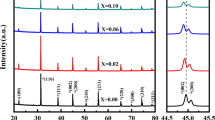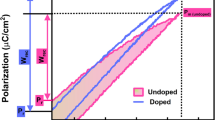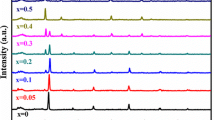Abstract
The praseodymium Pr3+ doped at Bi site of Ba0.1Bi0.9(Ti0.9Zr0.1)0.1Fe0.9O3, under low concentrations (0%, 0.1%, 0.5% and 1% abbreviated as BBTZF0, Pr-BBTZF001, Pr-BBTZF005 and Pr-BBTZF01, respectively) were prepared by the solid-state reaction method. A detailed investigation has been made on structural, microstructural, ferroelectric and dielectric properties of Ba0.1(Bi1−xPrx)0.9(Ti0.9Zr0.1)0.1Fe0.9O3 ceramics. Rietveld refinement fitting revealed that the structure of these ceramics, at room temperature is rhombohedral with space group R3c. The cell volume decreased with increasing Pr-content due to the smaller ionic radius of the Pr. Temperature dependence of the dielectric constant (ε′r) of all prepared ceramics showed anomaly around TN (antiferromagnetic transition temperature); thus suggesting a magneto-electric coupling in these materials. The shift of TN with frequency is attributed to the Maxwell Wagner relaxation rather than the relaxor behavior. The P–E loop study shows the improved ferroelectric behavior and the reduced leakage current density with Pr doping. Moreover, the energy storage properties showed a clear enhancement upon the increase of the Pr concentration. The recoverable energy storage density (Wrec) of 2.75 J cm−3 with energy storage efficiency (η) of 44.52% was achieved for Pr-BBTZF01.






Similar content being viewed by others

Data availability
There is no data included.
References
G. Catalan, J.F. Scott, Physics and applications of bismuth ferrite. Adv. Mater. 21, 2463 (2009). https://doi.org/10.1002/adma.200802849
W. Eerenstein, N.D. Mathur, J.F. Scott, Multiferroic and magnetoelectric materials. Nature 442, 759 (2006). https://doi.org/10.1038/nature05023
S.V.V. Khikhlovskyi, G. Blake, The renaissance of multiferroics: bismuth ferrite (BiFeO3)—a candidate multiferroic material in nanoscience. PhD Thesis (2010)
D.I. Khomskii, Multiferroics: different ways to combine magnetism and ferroelectricity. J. Magn. Magn. Mater. 306, 1 (2006). https://doi.org/10.1016/j.jmmm.2006.01.238
S.W. Cheong, M. Mostovoy, Multiferroics: a magnetic twist for ferroelectricity. Nat. Mater. 6, 13 (2007). https://doi.org/10.1038/nmat1804
S.G. Bahoosh, J.M. Wesselinowa, Origin of the different multiferroism in BiFeO3 and GaFeO3. J. Appl. Phys. 113, 063905 (2013). https://doi.org/10.1063/1.4791586
F. Bhadala, V.K. Jha, L. Suthar, M. Roy, Synthesis, structural, electrical and thermal properties of ScFeO3 ceramic. Am. J. Mod. Phys. 6(6), 132 (2017). https://doi.org/10.11648/j.ajmp.20170606.14
A. Ali, I. Khan, Z. Ali, F. Khan, I. Ahmad, First-principles study of BiFeO3 and BaTiO3 in tetragonal structure. Int. J. Mod. Phys. B 33(21), 1950231 (2019). https://doi.org/10.1142/S021797921950231X
A.A. Belik, Solid solutions between PbVO3 and BiCoO3. Inorg. Chem. 60, 4957 (2021). https://doi.org/10.1021/acs.inorgchem.1c00030
A. Ali, H.I. Elsaeedy, S. Ullah, S.A. Khan, I. Khan, First-principles study of polar magnets corundum double-oxides Mn2FeMO6 (M = W and Mo). J. Magn. Magn. Mater. 563, 169942 (2022). https://doi.org/10.1016/j.jmmm.2022.169942
A. Ali, H.E. Ali, I. Khan, Investigations of the structural, magnetic, mechanical, electronic and ferroelectric properties of Mn2MnWO6 double corundum oxide. Mater. Chem. Phys. 296, 127197 (2023). https://doi.org/10.1016/j.matchemphys.2022.127197
I. Sosnowska, R. Przenioslo, P. Fischer, V.A. Murashov, Investigation of crystal and magnetic structure of BiFeO3 using neutron diffraction. Acta Phys. Pol. A. 86(4), 629 (1994). https://doi.org/10.12693/APhysPolA.86.629
Y.F. Cui, Y.G. Zhao, L.B. Luo, J.J. Yang, H. Chang, M.H. Zhu, D. Xie, T.L. Ren, Dielectric, magnetic, and magnetoelectric properties of La and Ti codoped BiFeO3. Appl. Phys. Lett. 97, 222904 (2010). https://doi.org/10.1063/1.3524225
I. Kallel, H. Khemakhem, Z. Sassi, N. Abdelmoula, E.-K. Hlil, N. Randrianantoandro, The origin of the large magnetoelectric coupling in the ceramic Ba0.1Bi0.9(Ti0.9Zr0.1)0.1Fe0.9O3. J. Phys. D Appl. Phys. 55(6), 065303 (2022). https://doi.org/10.1088/1361-6463/ac2c3a
C.M. Fernandez-Posada, A. Castro, J.-M. Kiat, F. Porcher, O. Pena, M. Alguero, H. Amorin, A novel perovskite oxide chemically designed to show multiferroic phase boundary with room-temperature magnetoelectricity. Nat. Commun. 7, 12772 (2016). https://doi.org/10.1038/ncomms12772
S.-C. Yang, A. Kumar, V. Petkov, S. Priya, Room-temperature magnetoelectric coupling in single-phase BaTiO3-BiFeO3 system. J. Appl. Phys. 113, 144101 (2013). https://doi.org/10.1063/1.4799591
E.V. Ramana, A. Mahajan, M.P.F. Graca, A. Srinivas, M.A. Valente, Ferroelectric and magnetic properties of magnetoelectric (Na0.5Bi0.5)TiO3–BiFeO3 synthesized byacetic acid assisted sol–gel method. J. Eur. Ceram. Soc. 34(16), 4201 (2014). https://doi.org/10.1016/j.jeurceramsoc.2014.06.027
Y.-J. Wu, X.-K. Chen, J. Zhang, X.-J. Chen, Magnetic enhancement across a ferroelectric–antiferroelectric phase boundary in Bi1−xNdxFeO3. J. Appl. Phys. 111(5), 053927 (2012). https://doi.org/10.1063/1.3693531
J. Bielecki, P. Svedlindh, D.T. Tibebu, S. Cai, S.-G. Eriksson, L. Borjesson, C.S. Knee, Structural and magnetic properties of isovalently substituted multiferroic BiFeO3: insights from Raman spectroscopy. Phys. Rev. B. 86(18), 184422 (2012). https://doi.org/10.1103/PhysRevB.86.184422
S. Madolappa, S. Kundu, R. Bhimireddi, K.B.R. Varma, Improved electrical characteristics of Pr-doped BiFeO3 ceramics prepared by sol–gel route. Mater. Res. Express 3(6), 065009 (2016). https://doi.org/10.1088/2053-1591/3/6/065009
M. Muneeswaran, R. Dhanalakshmi, N.V. Giridharan, Structural, vibrational, electrical and magnetic properties of Bi1−xPrxFeO3. Ceram. Int. 41(7), 8511 (2015). https://doi.org/10.1016/j.ceramint.2015.03.058
S.K. Srivastav, N.S. Gajbhiye, A. Banerjee, Structural transformation and enhancement in magnetic properties of single-phase Bi1−xPrxFeO3 nanoparticles. J. Appl. Phys. 113, 203917 (2013). https://doi.org/10.1063/1.4807928
C. Singh, S.B. Narang, I.S. Hudiara, Y. Bai, F. Tabatabaei, Static magnetic properties of Co and Ru substituted Ba–Sr ferrite. Mater. Res. Bull. 43, 176 (2008). https://doi.org/10.1016/j.materresbull.2007.06.050
J. Rodriguez-Carvajal, Program Fullprof, Laboratoire Léon Brillouin, CEA-CNRS, 2015 version February 2015, LLB-LCSIM.
P.C. Sati, M. Kumar, S. Chhoker, Low temperature ferromagnetic ordering and dielectric properties of Bi1−xDyxFeO3 ceramics. Cearm. Int. 41(2), 3227 (2015). https://doi.org/10.1016/j.ceramint.2014.11.012
P.C. Sati, M. Sahni, M. Kumar, M. Arora, P. Negi, M. Tomar, V. Gupta, N. Kumar, Effect of Pr3+ substitution on structural, dielectric, electrical and magnetic properties of BiFe0.80Ti0.20O3 [Bi1-xPrxFe0.80Ti0.20O3, x=0.05, 0.10, 0.15] ceramics. Integr. Ferroelectr. 193, 1 (2018). https://doi.org/10.1080/10584587.2018.1514876
H. Maleki, Characterization and photocatalytic activity of Y-doped BiFeO3 ceramics prepared by solid-state reaction method. Adv. Powder Technol. 30(11), 2832 (2019). https://doi.org/10.1016/j.apt.2019.08.031
H. Maleki, Photocatalytic activity, optical and ferroelectric properties of Bi0.8Nd0.2FeO3 nanoparticles synthesized by sol-gel and hydrothermal methods. J. Magn. Magn. Mater. 458, 277 (2018). https://doi.org/10.1016/j.jmmm.2018.03.043
M.A. Basith, A. Billah, M.A. Jalil, N. Yesmin, M.A. Sakib, E.K. Ashik, S.M.E.H. Yousuf, S.S. Chowdhury, M.S. Hossain, S.H. Firoz, B. Ahmmad, The 10% Gd and Ti co-doped BiFeO3: a promising multiferroic material. J. Alloy. Compd. 694, 792 (2017). https://doi.org/10.1016/j.jallcom.2016.10.018
X. Li, X. Wang, Y. Li, W. Mao, P. Li, T. Yang, J. Yang, Structural, morphological and multiferroic properties of Pr and Co co-substituted BiFeO3 nanoparticles. Mater. Lett. 90, 152 (2013). https://doi.org/10.1016/j.matlet.2012.09.038
C.-S. Chen, P.-Y. Chen, W.S. Chang, C. Blaise, Y.L. Hsieh, R.R. Chien, V.H. Schmidt, Y.-S. Jou, C.-S. Tu, Evolution of domain structure and ferroelectric polarization in praseodymium doped BiFeO3 ceramics. Mater. Res. Bull. 133, 111054 (2021). https://doi.org/10.1016/j.materresbull.2020.111054
P. Ravindran, R. Vidya, A. Kjekshus, H. Fjellvåg, O. Eriksson, Theoretical investigation of magnetoelectric behavior in BiFeO3. Phys. Rev. B 74, 224412 (2006). https://doi.org/10.1103/PhysRevB.74.224412
F. Yan, Y. Shi, X. Zhou, K. Zhu, B. Shen, J. Zhai, Optimization of polarization and electric field of bismuth ferrite-based ceramics for capacitor applications. Chem. Eng. J. 417, 127945 (2021). https://doi.org/10.1016/j.cej.2020.127945
G. Wang, J. Li, X. Zhang, Z. Fan, F. Yang, A. Feteira, D. Zhou, D.C. Sinclair, T. Ma, X. Tan, D. Wang, I.M. Reaney, Ultrahigh energy storage density lead-free multilayers by controlled electrical homogeneity. Energy Environ. Sci. 12(2), 582 (2019). https://doi.org/10.1039/C8EE03287D
D. Zheng, R. Zuo, D. Zhang, Y. Li, X. Tan, Novel BiFeO3–BaTiO3 –Ba(Mg1/3Nb2/3)O3 lead-free relaxor ferroelectric ceramics for energy-storage capacitors. J. Am. Ceram. Soc. 98(9), 2692 (2015). https://doi.org/10.1111/jace.13737
N. Liu, R. Liang, X. Zhao, C. Xu, Z. Zhou, X. Dong, Novel bismuth ferrite-based lead-free ceramics with high energy and power density. J. Am. Ceram. Soc. 101(8), 3259 (2018). https://doi.org/10.1111/jace.15546
D. Wang, Z. Fan, D. Zhou, A. Khesro, S. Murakami, A. Feteira, Q. Zhao, X. Tan, I.M. Reaney, Bismuth ferrite-based lead-free ceramics and multilayers with high recoverable energy density. J. Mater. Chem. A 6, 4133 (2018). https://doi.org/10.1039/C7TA09857J
X. Gao, Y. Li, J. Chen, C. Yuan, M. Zeng, A. Zhang, X. Gao, X. Lu, Q. Li, J.-M. Liu, High energy storage performances of Bi1−xSmxFe0.95Sc0.05O3 lead-free ceramics synthesized by rapid hot press sintering. J. Eur. Ceram. Soc. 39(7), 2331 (2019). https://doi.org/10.1016/j.jeurceramsoc.2019.02.009
F. Li, J. Zhai, B. Shen, H. Zeng, X. Jian, S. Lu, Multifunctionality of lead-free BiFeO3-based ergodic relaxor ferroelectric ceramics: High energy storage performance and electrocaloric effect. J. Alloy. Compd. 803, 185 (2019). https://doi.org/10.1016/j.jallcom.2019.05.367
Acknowledgements
The authors acknowledge the financial support provided by Laboratory of Multifunctional Materials and Applications (LaMMA), (LR16ES18), Faculty of Sciences of Sfax, University of Sfax (Tunisia).
Author information
Authors and Affiliations
Contributions
All authors contributed to the present manuscript. Material synthesis, data collection, and analysis were performed by DSAK, ZA, NA and HK. YH and DM contribute to the energy storage studies especially in P = f(E) measurements. The first draft of the manuscript was written by DSAK with the cooperation of ZA and all other authors commented on the previous versions of the manuscript. All authors read and approved the final draft of the manuscript.
Corresponding author
Ethics declarations
Conflict of interest
The authors declare that they have no conflict of interest. The authors declare that they have no known competing financial interests or personal relationships that could have appeared to influence the work reported in this paper.
Research data policy and data availability statements
The available in the article are true and valid which are recognized by the authors.
Additional information
Publisher's Note
Springer Nature remains neutral with regard to jurisdictional claims in published maps and institutional affiliations.
Rights and permissions
Springer Nature or its licensor (e.g. a society or other partner) holds exclusive rights to this article under a publishing agreement with the author(s) or other rightsholder(s); author self-archiving of the accepted manuscript version of this article is solely governed by the terms of such publishing agreement and applicable law.
About this article
Cite this article
Khadir, D.S.A., Abdelkafi, Z., Hadouch, Y. et al. Effect of Pr3+ substitution on structural, dielectric and energy storage properties of Ba0.1Bi0,9(Ti0.9Zr0.1)0.1Fe0.9O3 ceramic. Appl. Phys. A 129, 519 (2023). https://doi.org/10.1007/s00339-023-06787-8
Received:
Accepted:
Published:
DOI: https://doi.org/10.1007/s00339-023-06787-8



